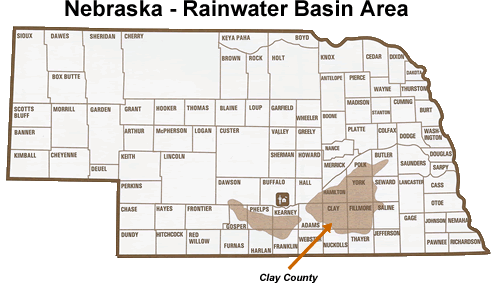South Central Nebraska is the land that inspired Pulitzer Prize-winning author Willa Cather to write:
“There is something frank and joyous and young in the open face of the country.”
O Pioneers! Part II Neighboring Fields Chapter I
NATURAL ATTRACTIONS
South Central Nebraska has been blessed with abundant natural resources that delight and benefit both residents and visitors to the area.
Rainwater Basin
 Clay County is in the middle of the Rainwater Basin which is the name given to the 17 county area in South Central Nebraska that is dotted with shallow marshland basins which attract waterfowl during their spring migration. This Basin, covering almost a 4,200 square mile area, consists of 10,000 acres and approximately 400 wetlands.
Clay County is in the middle of the Rainwater Basin which is the name given to the 17 county area in South Central Nebraska that is dotted with shallow marshland basins which attract waterfowl during their spring migration. This Basin, covering almost a 4,200 square mile area, consists of 10,000 acres and approximately 400 wetlands.
These wetlands are depressions in the ground layered with clay which traps rainwater and snow melt and forms natural marshes. These marshes warm quickly in the spring and provide both food and rest to the millions of waterfowl who migrate through the area each spring.
The U.S. Fish and Wildlife Service, the Nebraska Game and Parks Commission and private conservation groups have worked together to restore drained wetlands and protect existing wetlands in the area. Rainwater Basin wetlands in Clay County include:
| Federal Waterfowl Production Areas | State Wildlife Management Areas | |
| – Harvard – Hultine – Verona – Lange – Theesen – Glenvil – Massie – Harms |
– Moger – Meadowlark – Green Acres – Eckhardt – Shuck – Smith – Hansen |
– Kissinger Basin – Greenhead – Greenwing – Bulrush – Bluewing – White-Front |
Central Flyway for Snow Geese and other Water Fowl
One of the great natural wonders of the world is the migration of water-birds, especially snow geese, from their wintering areas in the south through the center of the United States to their breeding grounds in the north.
This migration path is shaped like an hourglass. Located right in the center and most narrow part of the path is South Central Nebraska and the Rainwater Basin.
The spring migration of snow geese through Nebraska is unmatched by any other place in North America and the path they take is called the Central Flyway. Waterfowl biologists believe this Midcontinent population of snow geese numbers 6 to 8 million birds.
Truly a bird-watching and waterfowl hunting delight.
Little Blue River
The Little Blue River, bubbling quietly along through South Central Nebraska, provides a geologic separation to the land on either side of the river. The flat fertile Plains lying above the valley are usually to the north side of the Little Blue and provide great agricultural opportunities.
The hilly Dissected Plains, eroded by water and wind, usually lie to the south of the Little Blue River. The steep slopes and sharp ridge crests of this hilly land provides beautiful scenery and wonderful wildlife habitat.
The Little Blue River in South Central Nebraska begins south of Minden and journeys in an east-to-southeasterly direction before leaving the Nebraska state boundary southeast of Fairbury, Nebraska.
The Little Blue River converges with the Big Blue River about 35 miles into Kansas and ultimately empties into Tuttle Creek Lake in northeast Kansas.
Republican River
The Republican River in south western and South Central Nebraska is considered one of Nebraska’s canoe trails. The river is flanked by hilly land with moderate to steep loess slopes and sharp ridge crests. The Republican River Valley is one to two miles wide and is occupied by farmland.
Among the stands of cottonwood and willows are deer, turkeys, beavers, herons, coyotes, foxes and channel catfish in the river.
The Republican River begins in extreme southwestern Nebraska where the North Fork Republican and the Arikaree Rivers out of Colorado converge. It is also fed by the South Fork Republican further east at Benkelman, NE. From there is flows more than 200 miles east through southwestern and South Central Nebraska until it enters Kansas south east of Superior, NE, eventually dumping into Milford Lake in northeast Kansas by Junction City, Kansas.
Clear Night Sky
A pristine, clear night sky, with very little light pollution, can be found in South Central Nebraska – perfect for phenomenal stargazing.
Sunsets
“The beauty of the sunsets compliments the peacefulness of life in”…South Central Nebraska.
Wide-Open Spaces
“The wide-open spaces allow for room to build, expand and enjoy life.”
Conserving the Resources of South Central Nebraska
Various governmental groups are dedicated to preserving, protecting and providing access to the natural resources of South Central Nebraska. The U.S. Fish and Wildlife Service and the Nebraska Game and Parks Commission were previously mentioned as providing such services.
Nebraska Natural Resource Districts
Twenty-three (23) Natural Resource Districts in Nebraska are dedicated to the wise use and conservation of our water, soil, woodlands and wildlife. The primary goals of the Natural Resource Districts are to:
- maintain water quality
- reduce flood potential
- reduce soil erosion
- provide outdoor recreation
- develop/improve fish & wildlife habitat
- educate on natural resources
Natural Resource Districts in the South Central PPD service area include the Little Blue Natural Resource District and the Lower Republican Natural Resource District.
Trailblazer RC&D
In addition, the Trailblazer Resource Conservation & Development (RC&D) Council, 402-746-3560, is one of eight councils in Nebraska that tackles issues affecting the vitality of rural communities. The Trailblazer RC&D receives funding from the USDA Natural Resources Conservation Service and includes the service area of South Central PPD. The Trailblazer RC&D is devoted to the environment, tourism and recreation, community leadership, entrepreneurship, and sustainable agriculture.
HISTORICAL ATTRACTIONS
South Central Nebraska has a rich legacy of involvement in history-making events that shaped our country.
The Oregon Trail, the Pony Express and the railroads—historic corridors that passed through South Central Nebraska—provide a connection of people and places with these historical attractions.
The Oregon Trail started from Independence, Missouri, followed the Kansas River west and then the Little Blue River north into Nebraska. The quarter million pioneers that used this trail from 1841 to 1869 traversed Nuckolls County in South Central Nebraska as they followed this 2000 mile trail to Oregon. Many historical markers, sites and events celebrate the passage of this famous trail through the area of South Central Nebraska.
The Pony Express followed the same Oregon Trail route through South Central Nebraska in delivering mail between St. Joseph, Missouri and Sacramento, California. The fabled Pony Express only ran for 18 months, from April 3, 1860 to late October, 1861, as a means of drawing public attention to the dreams of the Central Overland California and Pikes Peak Express Company in gaining the million dollar government mail contract.
The completion of the Union Pacific Railroad in 1869 marked the end of the Oregon Trail and the need for the Pony Express. The history of the Union Pacific Railroad began while it was still common for many travelers to walk alongside their wagons across the Great Plains of Nebraska following this Oregon Trail. Today, the Union Pacific Mainline continues to follow the Platte River across the State of Nebraska with the southern branch of the UP mainline bisecting Clay County as it heads for Marysville, Kansas from the switching yard in Hastings, NE. The towns of Glenvil, Fairfield, and Edgar in the South Central PPD service area are on this Union Pacific line and share in the legacy of the UP railroad.
Catherland/Willa Cather Pioneer Memorial – The western half of Webster County was officially proclaimed as “Catherland” by the Nebraska State Legislature in 1965. The Willa Cather Pioneer Memorial has preserved and restored sites in Red Cloud, NE, important to the life and works of Willa Cather, a native of Red Cloud, NE.
The historic Naval Ammunition Depot (NAD) was the largest Navy ammunition plant (48,743 acres) in operation during WWII and is located in part of Clay County on Highway 6, east of Hastings. As part of President Franklin Roosevelt’s “Arsenal of Democracy”, construction on this military installation for the production and storage of bombs, mines and ammunition began within a matter of months after the attack on Pearl Harbor by the Japanese on Dec. 7, 1941. Many buildings and storage bunkers can still be viewed while driving through the grounds.
Starke Round Barn, located east of Red Cloud, NE, is Nebraska’s largest round barn.
Museums
Historical museums exist in South Central Nebraska that preserve and display the rich legacy of the area.
| Clay County Historical Museum – Clay Center | 402-762-3563 |
| Nuckolls County Historical Museum – Superior | 402-879-3005 |
| Oak Historical Museum – Oak | |
| Webster County Historical Museum – Red Cloud | 402-746-2444 |
| Willa Cather Pioneer Memorial Museum – Red Cloud | 866-731-7304 |
State Historical Site
The Nebraska State Historical Society operates a state-wide network of history facilities. The Willa Cather Foundation is located in Red Cloud and pays tribute to the Pulitzer Prize-winning author who grew up in the area. The historic site includes six period structures that influenced her writing, including her childhood home, the Catholic and Episcopal churches, the Garber Bank, the Burlington Depot and the Pavelka Farmstead.






